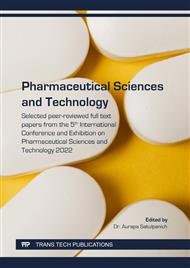[1]
Benedict, R.G. and A.F. Langlykke, Antibiotic activity of Bacillus polymyxa. Journal of Bacteriology, 1947. 54(1): p.24.
Google Scholar
[2]
Zakuan, Z.D. and K. Suresh, Rational use of intravenous polymyxin B and colistin: A review. Medical Journal of Malaysia, 2018. 73(5): pp.351-359.
Google Scholar
[3]
Cai, Y., W. Lee, and A.L. Kwa, Polymyxin B versus colistin: an update. Expert Review of Anti-infective Therapy, 2015. 13(12): pp.1481-1497.
DOI: 10.1586/14787210.2015.1093933
Google Scholar
[4]
Kubin, C., et al., Incidence and predictors of acute kidney injury associated with intravenous polymyxin B therapy. Journal of infection, 2012. 65(1): pp.80-87.
DOI: 10.1016/j.jinf.2012.01.015
Google Scholar
[5]
Yun, B., et al., Imaging the distribution of polymyxins in the kidney. Journal of Antimicrobial Chemotherapy, 2015. 70: pp.827-829.
Google Scholar
[6]
Abdelraouf, K., et al., Uptake of Polymyxin B into Renal Cells. Antimicrobial Agents and Chemotherapy, 2014. 58(7): pp.4200-4202.
DOI: 10.1128/aac.02557-14
Google Scholar
[7]
Azed, M.A.K., et al., Major pathways of polymyxin-induced apoptosis in rat kidney proximal tubular cells. Antimicrobial agents and chemotherapy, 2015. 59(4): pp.2136-2143.
DOI: 10.1128/aac.04869-14
Google Scholar
[8]
Vattimo, M.d.F.F., et al., Polymyxin B nephrotoxicity: from organ to cell damage, 2016. 11(8): p.e0161057.
Google Scholar
[9]
Temboot, P., et al., Potential of sodium deoxycholate sulfate as a carrier for polymyxin B: Physicochemical properties, bioactivity and in vitro safety. Journal of Drug Delivery Science and Technology, 2020. 58: p.101779.
DOI: 10.1016/j.jddst.2020.101779
Google Scholar
[10]
Gangadhar, K.N., K. Adhikari, and T. Srichana, Synthesis and evaluation of sodium deoxycholate sulfate as a lipid drug carrier to enhance the solubility, stability and safety of an amphotericin B inhalation formulation. International Journal of Pharmaceutics, 2014. 415(1-2): pp.430-438.
DOI: 10.1016/j.ijpharm.2014.05.066
Google Scholar
[11]
Severino, P., et al., Validation of an UV spectrophotometric assay for the quantification of polymyxin B in solid lipid nanoparticles. Archiv der Pharmazie, 2015. 70(11): pp.693-697.
Google Scholar
[12]
Mosmann, T., Rapid colorimetric assay for cellular growth and survival: application to proliferation and cytotoxicity assays. Journal of immunological methods, 1983. 65(1-2): pp.55-63.
DOI: 10.1016/0022-1759(83)90303-4
Google Scholar
[13]
Berridge, M.V. and A.S. Tan, Characterization of the cellular reduction of 3-(4,5-dimethylthiazol-2-yl)-2,5-diphenyltetrazolium bromide (MTT): subcellular localization, substrate dependence, and involvement of mitochondrial electron transport in MTT reduction. Archives of Biochemistry and Biophysics, 1993. 303(2): pp.474-482.
DOI: 10.1006/abbi.1993.1311
Google Scholar
[14]
Effenberger-Neidnicht, K. and M. Hartmann, Mechanisms of Hemolysis During Sepsis. Inflammation, 2018. 41(5): pp.1569-1581.
DOI: 10.1007/s10753-018-0810-y
Google Scholar
[15]
Thomas, C.E., Effect of polymyxin B on the hemolytic mechanism of the genus Listeria. Revista Argentina de Microbiología, 1993. 23(3): pp.123-129.
Google Scholar


